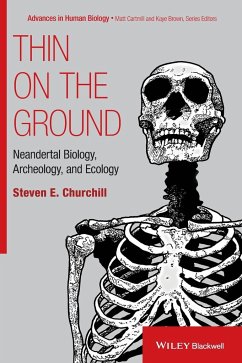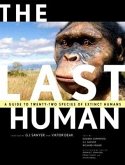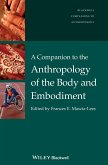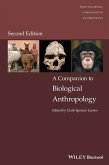- Gebundenes Buch
- Merkliste
- Auf die Merkliste
- Bewerten Bewerten
- Teilen
- Produkt teilen
- Produkterinnerung
- Produkterinnerung
"Integrates current understanding of the biology, archeology, and ecology of Neandertals"--
Andere Kunden interessierten sich auch für
![The Last Human The Last Human]() Esteban SarmientoThe Last Human55,99 €
Esteban SarmientoThe Last Human55,99 €![The Missing Lemur Link The Missing Lemur Link]() Ivan NorsciaThe Missing Lemur Link114,99 €
Ivan NorsciaThe Missing Lemur Link114,99 €![A Companion to the Anthropology of the Body and Embodiment A Companion to the Anthropology of the Body and Embodiment]() A Companion to the Anthropology of the Body and Embodiment272,99 €
A Companion to the Anthropology of the Body and Embodiment272,99 €![The Molecular Biology of Steroid and Nuclear Hormone Receptors The Molecular Biology of Steroid and Nuclear Hormone Receptors]() Leonard P FreedmanThe Molecular Biology of Steroid and Nuclear Hormone Receptors159,99 €
Leonard P FreedmanThe Molecular Biology of Steroid and Nuclear Hormone Receptors159,99 €![Human Brain Evolution Human Brain Evolution]() Human Brain Evolution202,99 €
Human Brain Evolution202,99 €![Companion to Paleopathology Companion to Paleopathology]() Companion to Paleopathology270,99 €
Companion to Paleopathology270,99 €![A Companion to Biological Anthropology A Companion to Biological Anthropology]() A Companion to Biological Anthropology210,99 €
A Companion to Biological Anthropology210,99 €-
-
-
"Integrates current understanding of the biology, archeology, and ecology of Neandertals"--
Hinweis: Dieser Artikel kann nur an eine deutsche Lieferadresse ausgeliefert werden.
Hinweis: Dieser Artikel kann nur an eine deutsche Lieferadresse ausgeliefert werden.
Produktdetails
- Produktdetails
- Verlag: Wiley
- Seitenzahl: 472
- Erscheinungstermin: 6. Oktober 2014
- Englisch
- Abmessung: 260mm x 183mm x 30mm
- Gewicht: 1074g
- ISBN-13: 9781118590874
- ISBN-10: 1118590872
- Artikelnr.: 40546315
- Herstellerkennzeichnung
- Libri GmbH
- Europaallee 1
- 36244 Bad Hersfeld
- gpsr@libri.de
- Verlag: Wiley
- Seitenzahl: 472
- Erscheinungstermin: 6. Oktober 2014
- Englisch
- Abmessung: 260mm x 183mm x 30mm
- Gewicht: 1074g
- ISBN-13: 9781118590874
- ISBN-10: 1118590872
- Artikelnr.: 40546315
- Herstellerkennzeichnung
- Libri GmbH
- Europaallee 1
- 36244 Bad Hersfeld
- gpsr@libri.de
Steven E. Churchill is Professor of Evolutionary Anthropology at Duke University. A recognized leader in the field of physical anthropology, Dr. Churchill is the author of more than 50 research articles on the morphology and behavior of Neandertals and early modern humans.
Series Introduction ix
Preface xi
Acknowledgements xv
Chapter 1 Thin on the Ground: Population Density and Technological
Innovation 1
Note 7
Chapter 2 The Neandertals in Time and Space 9
2.1 Geographic and Temporal Boundaries 10
2.2 Defining the Neandertals 13
2.3 Neandertal DNA 27
2.4 Neandertal Taxonomy 30
2.5 Regional and Temporal Variation in Neandertal Morphology 30
2.6 The Evolutionary History of the Neandertals 32
Notes 39
Chapter 3 Neandertal Material Culture 41
3.1 Neandertal-associated Lithic Industries 42
3.2 Variation in the Eurasian Middle Paleolithic: Technology as Adaptive
Interface 53
3.3 Composite Technology, and the Archeologically Less-visible Component of
Technology 59
3.4 Subsistence Technology 61
3.5 Domestic Technology 67
Notes 69
Chapter 4 The Body Neandertal 71
4.1 Neandertal Body Size: Short but Massive 72
4.2 Body Composition: "Scaled Up" Inuit? 79
4.3 The Cost of Size: Feeding a Large Body and Large Brain 82
4.3.1 Nutrition and Somatic Maintenance: Neandertal Bodies were
Energetically Costly 83
4.3.2 Nutrition and Reproduction: Were Neandertal Mothers Like Polar Bears?
92
4.3.3 Dietary Shortfalls: Hard and Lean Winters 97
4.4 The Benefits of Size: Neandertal Body Size in Ecological Context 99
Notes 104
Chapter 5 Surviving the Cold 107
5.1 How Cold Was It? 108
5.1.1 Cold-Temperate Conditions (MIS 5d-a and 3) 109
5.1.2 Cold Glacial Conditions (MIS 6 and 4) 111
5.2 Human Adaptation to the Cold 114
5.3 Cold Adaptation and Neandertal Morphology 117
5.3.1 The Survival Value of Neandertal Body Form 124
5.3.2 Craniofacial Morphology and Cold Adaptation 129
5.4 Physiological Solutions to Cold Stress 137
5.5 Cold Stress and Neandertal Behavior 141
5.5.1 Activity 141
5.5.2 Extrasomatic Heat Production and Conservation: Fire, Shelter and
Clothing 142
5.6 Thermogenic Capacity and Cold Tolerance 146
5.7 The Neandertals Were Cold-adapted 148
Notes 149
Chapter 6 The Caloric Economy of Pleistocene Europe 151
6.1 Issues in the Reconstruction of Past Environments 152
6.2 Pleistocene Biomes of Europe and Western Asia 157
6.2.1 Interglacial Europe: Marine Isotope Stages 7 and 5e 159
6.2.2 Productivity and Edible Resources of Interglacial Environments 162
6.2.3 Temperate Interglacial Europe: Marine Isotope Stages 5d-a and 3 169
6.2.4 Cold Steppic Europe: Marine Isotope Stages 6 and 4 173
Notes 175
Chapter 7 Neandertals as Consumers 179
7.1 Analysis of Food Residues: The Macromammal Component of Neandertal Diet
181
7.2 Analysis of Food Residues: The Small Animal Data 187
7.3 Analysis of Food Residues: Macrobotanical Remains 191
7.4 Dental Wear and Food Residues on Teeth 194
7.5 Stable Isotope and Trace Element Analyses 200
7.6 The Thorny Issue of Cannibalism 214
7.7 The Trophic Ecology of Neandertals 216
Notes 218
Chapter 8 Red in Tooth and Claw: Neandertals as Predators 219
8.1 Neandertal Morphology and Predation 220
8.1.1 Scapular Glenoid Fossa 222
8.1.2 Elbow Joint Morphology 224
8.1.3 Superior Pubic Ramus Length 226
8.1.4 Humeral Diaphyseal Cross-sectional Geometry 226
8.1.5 Entheseal (Muscle Marking) Morphology 233
8.2 Neandertals as Close-range Predators 236
8.3 Prey Size, Hunting "Pack" Size, and Risk of Injury to Neandertal
Hunters 245
8.4 Neandertal Hunting in Ecological Context 246
Notes 249
Chapter 9 In the Company of Killers: Neandertals as Carnivores 251
9.1 Large-bodied Carnivores of the Eurasian Late Pleistocene 253
9.2 The Members of the Eurasian Pleistocene Large-bodied Carnivore Guild
256
9.2.1 Homotherium latidens 256
9.2.2 Panthera leo spelaea 258
9.2.3 Panthera pardus 259
9.2.4 Crocuta crocuta spelaea 260
9.2.5 Hyaena hyaena 262
9.2.6 Canis lupus 262
9.2.7 Cuon alpinus 263
9.3 Competition within the Carnivore Guild 264
9.3.1 Exploitation Competition 265
9.3.2 Interference Competition 268
9.4 Neandertals Were Not the Socially-Dominant Members of the Carnivore
Guild 271
9.5 Neandertal Ecology in the Context of Competition within the Carnivore
Guild 276
Notes 284
Chapter 10 The Cost of Living in Ice Age Europe 287
10.1 Subsistence Organization and Mobility 289
10.2 Home Range Size 299
10.2.1 Lithic Raw Material Movement 300
10.2.2 Carnivore Models for Estimating Neandertal Mobility 302
10.3 Paleontological Reflections of Neandertal Mobility 309
10.4 The Energetic Cost of Mobility 316
10.5 The Energetic Cost of Domestic Activities 321
10.6 Neandertal Physical Activity Levels 324
Notes 331
Chapter 11 Neandertal Social Life, Life History, and Demography 333
11.1 Subsistence Labor Demands, Group Size, and Social Structure 336
11.2 Neandertal Life History 342
11.3 Neandertal Demography 347
Notes 352
Chapter 12 From Thin to Thick: The African MSA 353
12.1 Tipping the Scales on Population Growth 355
12.2 Culture Change in the Late MSA and Mousterian 360
Note 363
References 365
Index 445
Preface xi
Acknowledgements xv
Chapter 1 Thin on the Ground: Population Density and Technological
Innovation 1
Note 7
Chapter 2 The Neandertals in Time and Space 9
2.1 Geographic and Temporal Boundaries 10
2.2 Defining the Neandertals 13
2.3 Neandertal DNA 27
2.4 Neandertal Taxonomy 30
2.5 Regional and Temporal Variation in Neandertal Morphology 30
2.6 The Evolutionary History of the Neandertals 32
Notes 39
Chapter 3 Neandertal Material Culture 41
3.1 Neandertal-associated Lithic Industries 42
3.2 Variation in the Eurasian Middle Paleolithic: Technology as Adaptive
Interface 53
3.3 Composite Technology, and the Archeologically Less-visible Component of
Technology 59
3.4 Subsistence Technology 61
3.5 Domestic Technology 67
Notes 69
Chapter 4 The Body Neandertal 71
4.1 Neandertal Body Size: Short but Massive 72
4.2 Body Composition: "Scaled Up" Inuit? 79
4.3 The Cost of Size: Feeding a Large Body and Large Brain 82
4.3.1 Nutrition and Somatic Maintenance: Neandertal Bodies were
Energetically Costly 83
4.3.2 Nutrition and Reproduction: Were Neandertal Mothers Like Polar Bears?
92
4.3.3 Dietary Shortfalls: Hard and Lean Winters 97
4.4 The Benefits of Size: Neandertal Body Size in Ecological Context 99
Notes 104
Chapter 5 Surviving the Cold 107
5.1 How Cold Was It? 108
5.1.1 Cold-Temperate Conditions (MIS 5d-a and 3) 109
5.1.2 Cold Glacial Conditions (MIS 6 and 4) 111
5.2 Human Adaptation to the Cold 114
5.3 Cold Adaptation and Neandertal Morphology 117
5.3.1 The Survival Value of Neandertal Body Form 124
5.3.2 Craniofacial Morphology and Cold Adaptation 129
5.4 Physiological Solutions to Cold Stress 137
5.5 Cold Stress and Neandertal Behavior 141
5.5.1 Activity 141
5.5.2 Extrasomatic Heat Production and Conservation: Fire, Shelter and
Clothing 142
5.6 Thermogenic Capacity and Cold Tolerance 146
5.7 The Neandertals Were Cold-adapted 148
Notes 149
Chapter 6 The Caloric Economy of Pleistocene Europe 151
6.1 Issues in the Reconstruction of Past Environments 152
6.2 Pleistocene Biomes of Europe and Western Asia 157
6.2.1 Interglacial Europe: Marine Isotope Stages 7 and 5e 159
6.2.2 Productivity and Edible Resources of Interglacial Environments 162
6.2.3 Temperate Interglacial Europe: Marine Isotope Stages 5d-a and 3 169
6.2.4 Cold Steppic Europe: Marine Isotope Stages 6 and 4 173
Notes 175
Chapter 7 Neandertals as Consumers 179
7.1 Analysis of Food Residues: The Macromammal Component of Neandertal Diet
181
7.2 Analysis of Food Residues: The Small Animal Data 187
7.3 Analysis of Food Residues: Macrobotanical Remains 191
7.4 Dental Wear and Food Residues on Teeth 194
7.5 Stable Isotope and Trace Element Analyses 200
7.6 The Thorny Issue of Cannibalism 214
7.7 The Trophic Ecology of Neandertals 216
Notes 218
Chapter 8 Red in Tooth and Claw: Neandertals as Predators 219
8.1 Neandertal Morphology and Predation 220
8.1.1 Scapular Glenoid Fossa 222
8.1.2 Elbow Joint Morphology 224
8.1.3 Superior Pubic Ramus Length 226
8.1.4 Humeral Diaphyseal Cross-sectional Geometry 226
8.1.5 Entheseal (Muscle Marking) Morphology 233
8.2 Neandertals as Close-range Predators 236
8.3 Prey Size, Hunting "Pack" Size, and Risk of Injury to Neandertal
Hunters 245
8.4 Neandertal Hunting in Ecological Context 246
Notes 249
Chapter 9 In the Company of Killers: Neandertals as Carnivores 251
9.1 Large-bodied Carnivores of the Eurasian Late Pleistocene 253
9.2 The Members of the Eurasian Pleistocene Large-bodied Carnivore Guild
256
9.2.1 Homotherium latidens 256
9.2.2 Panthera leo spelaea 258
9.2.3 Panthera pardus 259
9.2.4 Crocuta crocuta spelaea 260
9.2.5 Hyaena hyaena 262
9.2.6 Canis lupus 262
9.2.7 Cuon alpinus 263
9.3 Competition within the Carnivore Guild 264
9.3.1 Exploitation Competition 265
9.3.2 Interference Competition 268
9.4 Neandertals Were Not the Socially-Dominant Members of the Carnivore
Guild 271
9.5 Neandertal Ecology in the Context of Competition within the Carnivore
Guild 276
Notes 284
Chapter 10 The Cost of Living in Ice Age Europe 287
10.1 Subsistence Organization and Mobility 289
10.2 Home Range Size 299
10.2.1 Lithic Raw Material Movement 300
10.2.2 Carnivore Models for Estimating Neandertal Mobility 302
10.3 Paleontological Reflections of Neandertal Mobility 309
10.4 The Energetic Cost of Mobility 316
10.5 The Energetic Cost of Domestic Activities 321
10.6 Neandertal Physical Activity Levels 324
Notes 331
Chapter 11 Neandertal Social Life, Life History, and Demography 333
11.1 Subsistence Labor Demands, Group Size, and Social Structure 336
11.2 Neandertal Life History 342
11.3 Neandertal Demography 347
Notes 352
Chapter 12 From Thin to Thick: The African MSA 353
12.1 Tipping the Scales on Population Growth 355
12.2 Culture Change in the Late MSA and Mousterian 360
Note 363
References 365
Index 445
Series Introduction ix
Preface xi
Acknowledgements xv
Chapter 1 Thin on the Ground: Population Density and Technological
Innovation 1
Note 7
Chapter 2 The Neandertals in Time and Space 9
2.1 Geographic and Temporal Boundaries 10
2.2 Defining the Neandertals 13
2.3 Neandertal DNA 27
2.4 Neandertal Taxonomy 30
2.5 Regional and Temporal Variation in Neandertal Morphology 30
2.6 The Evolutionary History of the Neandertals 32
Notes 39
Chapter 3 Neandertal Material Culture 41
3.1 Neandertal-associated Lithic Industries 42
3.2 Variation in the Eurasian Middle Paleolithic: Technology as Adaptive
Interface 53
3.3 Composite Technology, and the Archeologically Less-visible Component of
Technology 59
3.4 Subsistence Technology 61
3.5 Domestic Technology 67
Notes 69
Chapter 4 The Body Neandertal 71
4.1 Neandertal Body Size: Short but Massive 72
4.2 Body Composition: "Scaled Up" Inuit? 79
4.3 The Cost of Size: Feeding a Large Body and Large Brain 82
4.3.1 Nutrition and Somatic Maintenance: Neandertal Bodies were
Energetically Costly 83
4.3.2 Nutrition and Reproduction: Were Neandertal Mothers Like Polar Bears?
92
4.3.3 Dietary Shortfalls: Hard and Lean Winters 97
4.4 The Benefits of Size: Neandertal Body Size in Ecological Context 99
Notes 104
Chapter 5 Surviving the Cold 107
5.1 How Cold Was It? 108
5.1.1 Cold-Temperate Conditions (MIS 5d-a and 3) 109
5.1.2 Cold Glacial Conditions (MIS 6 and 4) 111
5.2 Human Adaptation to the Cold 114
5.3 Cold Adaptation and Neandertal Morphology 117
5.3.1 The Survival Value of Neandertal Body Form 124
5.3.2 Craniofacial Morphology and Cold Adaptation 129
5.4 Physiological Solutions to Cold Stress 137
5.5 Cold Stress and Neandertal Behavior 141
5.5.1 Activity 141
5.5.2 Extrasomatic Heat Production and Conservation: Fire, Shelter and
Clothing 142
5.6 Thermogenic Capacity and Cold Tolerance 146
5.7 The Neandertals Were Cold-adapted 148
Notes 149
Chapter 6 The Caloric Economy of Pleistocene Europe 151
6.1 Issues in the Reconstruction of Past Environments 152
6.2 Pleistocene Biomes of Europe and Western Asia 157
6.2.1 Interglacial Europe: Marine Isotope Stages 7 and 5e 159
6.2.2 Productivity and Edible Resources of Interglacial Environments 162
6.2.3 Temperate Interglacial Europe: Marine Isotope Stages 5d-a and 3 169
6.2.4 Cold Steppic Europe: Marine Isotope Stages 6 and 4 173
Notes 175
Chapter 7 Neandertals as Consumers 179
7.1 Analysis of Food Residues: The Macromammal Component of Neandertal Diet
181
7.2 Analysis of Food Residues: The Small Animal Data 187
7.3 Analysis of Food Residues: Macrobotanical Remains 191
7.4 Dental Wear and Food Residues on Teeth 194
7.5 Stable Isotope and Trace Element Analyses 200
7.6 The Thorny Issue of Cannibalism 214
7.7 The Trophic Ecology of Neandertals 216
Notes 218
Chapter 8 Red in Tooth and Claw: Neandertals as Predators 219
8.1 Neandertal Morphology and Predation 220
8.1.1 Scapular Glenoid Fossa 222
8.1.2 Elbow Joint Morphology 224
8.1.3 Superior Pubic Ramus Length 226
8.1.4 Humeral Diaphyseal Cross-sectional Geometry 226
8.1.5 Entheseal (Muscle Marking) Morphology 233
8.2 Neandertals as Close-range Predators 236
8.3 Prey Size, Hunting "Pack" Size, and Risk of Injury to Neandertal
Hunters 245
8.4 Neandertal Hunting in Ecological Context 246
Notes 249
Chapter 9 In the Company of Killers: Neandertals as Carnivores 251
9.1 Large-bodied Carnivores of the Eurasian Late Pleistocene 253
9.2 The Members of the Eurasian Pleistocene Large-bodied Carnivore Guild
256
9.2.1 Homotherium latidens 256
9.2.2 Panthera leo spelaea 258
9.2.3 Panthera pardus 259
9.2.4 Crocuta crocuta spelaea 260
9.2.5 Hyaena hyaena 262
9.2.6 Canis lupus 262
9.2.7 Cuon alpinus 263
9.3 Competition within the Carnivore Guild 264
9.3.1 Exploitation Competition 265
9.3.2 Interference Competition 268
9.4 Neandertals Were Not the Socially-Dominant Members of the Carnivore
Guild 271
9.5 Neandertal Ecology in the Context of Competition within the Carnivore
Guild 276
Notes 284
Chapter 10 The Cost of Living in Ice Age Europe 287
10.1 Subsistence Organization and Mobility 289
10.2 Home Range Size 299
10.2.1 Lithic Raw Material Movement 300
10.2.2 Carnivore Models for Estimating Neandertal Mobility 302
10.3 Paleontological Reflections of Neandertal Mobility 309
10.4 The Energetic Cost of Mobility 316
10.5 The Energetic Cost of Domestic Activities 321
10.6 Neandertal Physical Activity Levels 324
Notes 331
Chapter 11 Neandertal Social Life, Life History, and Demography 333
11.1 Subsistence Labor Demands, Group Size, and Social Structure 336
11.2 Neandertal Life History 342
11.3 Neandertal Demography 347
Notes 352
Chapter 12 From Thin to Thick: The African MSA 353
12.1 Tipping the Scales on Population Growth 355
12.2 Culture Change in the Late MSA and Mousterian 360
Note 363
References 365
Index 445
Preface xi
Acknowledgements xv
Chapter 1 Thin on the Ground: Population Density and Technological
Innovation 1
Note 7
Chapter 2 The Neandertals in Time and Space 9
2.1 Geographic and Temporal Boundaries 10
2.2 Defining the Neandertals 13
2.3 Neandertal DNA 27
2.4 Neandertal Taxonomy 30
2.5 Regional and Temporal Variation in Neandertal Morphology 30
2.6 The Evolutionary History of the Neandertals 32
Notes 39
Chapter 3 Neandertal Material Culture 41
3.1 Neandertal-associated Lithic Industries 42
3.2 Variation in the Eurasian Middle Paleolithic: Technology as Adaptive
Interface 53
3.3 Composite Technology, and the Archeologically Less-visible Component of
Technology 59
3.4 Subsistence Technology 61
3.5 Domestic Technology 67
Notes 69
Chapter 4 The Body Neandertal 71
4.1 Neandertal Body Size: Short but Massive 72
4.2 Body Composition: "Scaled Up" Inuit? 79
4.3 The Cost of Size: Feeding a Large Body and Large Brain 82
4.3.1 Nutrition and Somatic Maintenance: Neandertal Bodies were
Energetically Costly 83
4.3.2 Nutrition and Reproduction: Were Neandertal Mothers Like Polar Bears?
92
4.3.3 Dietary Shortfalls: Hard and Lean Winters 97
4.4 The Benefits of Size: Neandertal Body Size in Ecological Context 99
Notes 104
Chapter 5 Surviving the Cold 107
5.1 How Cold Was It? 108
5.1.1 Cold-Temperate Conditions (MIS 5d-a and 3) 109
5.1.2 Cold Glacial Conditions (MIS 6 and 4) 111
5.2 Human Adaptation to the Cold 114
5.3 Cold Adaptation and Neandertal Morphology 117
5.3.1 The Survival Value of Neandertal Body Form 124
5.3.2 Craniofacial Morphology and Cold Adaptation 129
5.4 Physiological Solutions to Cold Stress 137
5.5 Cold Stress and Neandertal Behavior 141
5.5.1 Activity 141
5.5.2 Extrasomatic Heat Production and Conservation: Fire, Shelter and
Clothing 142
5.6 Thermogenic Capacity and Cold Tolerance 146
5.7 The Neandertals Were Cold-adapted 148
Notes 149
Chapter 6 The Caloric Economy of Pleistocene Europe 151
6.1 Issues in the Reconstruction of Past Environments 152
6.2 Pleistocene Biomes of Europe and Western Asia 157
6.2.1 Interglacial Europe: Marine Isotope Stages 7 and 5e 159
6.2.2 Productivity and Edible Resources of Interglacial Environments 162
6.2.3 Temperate Interglacial Europe: Marine Isotope Stages 5d-a and 3 169
6.2.4 Cold Steppic Europe: Marine Isotope Stages 6 and 4 173
Notes 175
Chapter 7 Neandertals as Consumers 179
7.1 Analysis of Food Residues: The Macromammal Component of Neandertal Diet
181
7.2 Analysis of Food Residues: The Small Animal Data 187
7.3 Analysis of Food Residues: Macrobotanical Remains 191
7.4 Dental Wear and Food Residues on Teeth 194
7.5 Stable Isotope and Trace Element Analyses 200
7.6 The Thorny Issue of Cannibalism 214
7.7 The Trophic Ecology of Neandertals 216
Notes 218
Chapter 8 Red in Tooth and Claw: Neandertals as Predators 219
8.1 Neandertal Morphology and Predation 220
8.1.1 Scapular Glenoid Fossa 222
8.1.2 Elbow Joint Morphology 224
8.1.3 Superior Pubic Ramus Length 226
8.1.4 Humeral Diaphyseal Cross-sectional Geometry 226
8.1.5 Entheseal (Muscle Marking) Morphology 233
8.2 Neandertals as Close-range Predators 236
8.3 Prey Size, Hunting "Pack" Size, and Risk of Injury to Neandertal
Hunters 245
8.4 Neandertal Hunting in Ecological Context 246
Notes 249
Chapter 9 In the Company of Killers: Neandertals as Carnivores 251
9.1 Large-bodied Carnivores of the Eurasian Late Pleistocene 253
9.2 The Members of the Eurasian Pleistocene Large-bodied Carnivore Guild
256
9.2.1 Homotherium latidens 256
9.2.2 Panthera leo spelaea 258
9.2.3 Panthera pardus 259
9.2.4 Crocuta crocuta spelaea 260
9.2.5 Hyaena hyaena 262
9.2.6 Canis lupus 262
9.2.7 Cuon alpinus 263
9.3 Competition within the Carnivore Guild 264
9.3.1 Exploitation Competition 265
9.3.2 Interference Competition 268
9.4 Neandertals Were Not the Socially-Dominant Members of the Carnivore
Guild 271
9.5 Neandertal Ecology in the Context of Competition within the Carnivore
Guild 276
Notes 284
Chapter 10 The Cost of Living in Ice Age Europe 287
10.1 Subsistence Organization and Mobility 289
10.2 Home Range Size 299
10.2.1 Lithic Raw Material Movement 300
10.2.2 Carnivore Models for Estimating Neandertal Mobility 302
10.3 Paleontological Reflections of Neandertal Mobility 309
10.4 The Energetic Cost of Mobility 316
10.5 The Energetic Cost of Domestic Activities 321
10.6 Neandertal Physical Activity Levels 324
Notes 331
Chapter 11 Neandertal Social Life, Life History, and Demography 333
11.1 Subsistence Labor Demands, Group Size, and Social Structure 336
11.2 Neandertal Life History 342
11.3 Neandertal Demography 347
Notes 352
Chapter 12 From Thin to Thick: The African MSA 353
12.1 Tipping the Scales on Population Growth 355
12.2 Culture Change in the Late MSA and Mousterian 360
Note 363
References 365
Index 445








